The tradition of Urdu dramas starts from Wajid Ali Shah’s Radha Kanhaiya Ka Qissa. Critiques, however, agree upon the fact that the history of Urdu dramas starts from the writing of Inder Sabha, by Amanat Lakhnavi, which marked an era of Urdu dramas. The next era belongs to Agha Hashr Kashmiri (1879-1935), who was associated with Parsi theatre and used to write plays in both Urdu and Hindi, keeping in mind the demand or the need of the Parsi theatre. For Agha Hashr Kashmiri, the most important thing was the choice of the viewer, the rest all was secondary. He occasionally pointed out some social malevolence and showed some of life’s beautiful and civilized aspects; he portrayed all these things upon the stage very artistically. Agha Hashr was aware of the significance of the theatre and also its impact on the masses. In one of his plays, Turki Hoor, he says through a character:
“Natak bhi sotey huye logon ko jaganey aur girey huon ko uthane ka eik zabardast zariya hai. Jo taraqqi ka, josh ka, islaah ka jazba saikdon waaz aur hazaron lecture sun kar barson men paida nahin hota who josh o jazba insaan ke andar behtar naatak eik raat men paida kar deta hai.”
(Theatre is a powerful medium to wake up people from slumber and to uplift the downtrodden. A good play can incite the sentiment for progress, reform and vigour in one night what thousands of lectures and sermons can’t achieve).
Agha Hashr Kashmiri and other dramatists realise the linguistic strength of Urdu and make the Parsi theatre a great source of entertainment for the masses. Besides the story, the sweetness of language, verses and a certain flow and theatricality in prose, among the other paraphernalia of stage, it holds the audience in a spell with a thorough and thundering spark. The plays were written and staged during this period were mostly for the entertainment of the common people.
Later, with the establishment of the Indian People’s Theatre Association (IPTA), the era of a new type of theatre started which was completely dedicated to the cause of common people and it was also fully noncommercial. We may call it the first “committed theatre”. It played a vital role in the development of the medium. The progressive writers were its backbone, central to its efflorescence. They wanted to portray with sympathy the stories of the joys and sorrows of the ordinary people of their time in literature which they heard from them in their language. IPTA has not just brought the great heritage of folk traditions to the Hindustani theatre but also instilled the sentiment among the common man that IPTA was shaping their dreams.
After IPTA, Prithviraj Kapoor established his “Prithvi Theatre” in 1944. It blended the political and social currents in its plays, written and produced by Prithviraj Kapoor. These plays were presented to the audience in a very organized manner. Some famous plays of this theatre were Deewar, Pathan, Ghaddar, Aahuti, Kalakar, Paisa, and Kisaan etc. The importance of the work done by Prithvi Raj Kapoor is immense. He travelled all over the country with his plays.
IPTA, on the other hand, started to link theatre with people, their problems, anxieties and aspirations, through its chapters. IPTA’s plays had an element of direct expression that could connect with the feelings, experiences and affairs of the masses. If Prithvi Theatre took the technique of theatre to greater heights, IPTA adopted the simplicity and directness of the stage for the masses. Both strove to give some message and sense of purpose through entertainment. Apart from this, other public platforms like Bahroopi, Little Theatre Group and Art Theatre were established. Among all of them, Prithvi Theatre tried to fill the need that was created after the deterioration of Parsi Theatre. Several plays produced under its banner, like Deewar, Pathan and Paisa were immensely popular for about 16-17 years. It travelled around the country, staging plays and gathering acclaim. The credit for all this goes to Prithviraj Kapoor’s charismatic personality, who played the lead roles in his plays and struggled for theatre for his entire life. The contribution of IPTA and Prithvi Theatre is remarkable in the development of Urdu theatre.
Habib Tanvir and his Theatrical Journey
In modern theatre, the name Habib Tanvir is prominent and needs no formal introduction. He was a renowned Hindi and Urdu playwright, a great director, actor, manager, poet, and one of the most important theatre personalities. He was also a progressive thinker, a humanist and a people’s artiste, who created a theatre embedded in the Indian soil and the realisation of our people, reflecting modern-day awareness. Noted film director Shyam Benegal once said about him:
“Habib Tanvir was unquestionably one of the greatest theatre producers, directors, actors and writers, and a pioneer of Hindustani theatre.”
His remarkable achievement and popularity in theatre was due to his lifelong practice, devotion and committed dedication. There are a number of plays to his credit. His keen interest in poetry and music found his first major expression on stage with Agra Bazar, which he wrote and produced in 1954. This was basically a personality play and was about Nazir Akbar Aabadi, the 18th century Urdu Poet and a legend in his lifetimes, who observed the Indian society with broad profundity and made it the topic of his poetry. His expression and language are popular, his understanding simple and lucid. His poetry was emblematic of human values which also mirror the Hindustani society.

Although the play was about him, he was nowhere on the stage. But his presence could be felt in the texture of the play. The reason was, as Habib Tanvir wrote in the preface:
“I wanted to make Nazir’s poetry and not his life the foundation of the theatre. During writing the play it occurred to me that not bringing Nazir to the stage would be better. In this way, not just many crucial stages of my themes were traversed, it also influenced my technique in many ways and technique and themes came to be blended.”
The play may be considered as key to rediscovering Nazir Akbar Aabadi. He did so without showing the poet on the stage, which proved to be a masterpiece of his oeuvre. Through this play, Habib has very skillfully captured the political, social and literary zeitgeist of the times. Writing about this play, eminent drama critic Javed Malik writes:
“His approach to folk culture distinguished itself sharply from that of many others in contemporary theatre. His approach to the folk in particular and his cultural consciousness in general were shaped in the crucible of the left-wing cultural movement- particularly Indian People’s Theatre Association (IPTA) and Progressive Writers Association (PWA) in which Tanvir actively participated during early, post university years.”
The play, Agra Bazar, was radical in its engagement with popular culture and use of street language. It gave immense joy to the theatre lovers. It was staged in 1954 at Jamia Millia Islamia for the first time on the occasion of “Youm-e Nazeer” with students, teachers and local villagers from Okhla and nearby places. In the first version of Agra Bazar the plot was entirely cantered on the Kakri-wala, who finds it difficult to sell his kakri until he gets Nazir to write a poem on it. He sings this poem and does brisk business. Gradually, another strand was added to the play, which concerned a prostitute and a police constable.
Habib Tanvir brilliantly portrays the two opposite poles on the stage. On the one hand, there is a kite shop, and on the other, a bookshop and in the middle lies the bazaar. Thus, he brought the entire social spectrum to the stage in one stroke. This had a lot to do with his democratic consciousness, which is beautifully reflected in his plays. He shares once that in Agra Bazar that he wanted to show the contrast to the working-class, that the educated privileged of Nazir’s time praised him as a person, but totally overlooked him as a poet. And this was the point that gave him an idea of the bookseller, who helps the play move ahead and whose shop becomes the two opposing poles of the marketplace. The play is marked by its imaginative plot and its inventive and simple story.
The next foremost theatrical landmark on Habib’s artistic path is Charandas Chor. The protagonist Charandas is a thief with a kind heart — he can’t bring himself to rob the helpless or the poor, but runs around policemen, greedy landlords and their strongmen and other such pillars of the establishment. Here the irony is that the whole system is corrupt.

Charandas Chor is derived from a folk tale about a thief who unintentionally makes a promise to his guru never to tell a lie. He always kept his promise, but he never stops thieving. The guru had actually asked him to give up his bad habit if he wanted to become his disciple. The thief offers to take four other vows instead: he will never eat off a golden plate, never ride an elephant at the head of a procession, never marry a queen, and never accept the throne of any country. To this, the guru retorts that as he had so generously undertaken to give up four things on his own account, he might undertake to give up one little thing at his guru’s request. “You are a big liar,” says the guru, “give up lying”. The thief agrees and that is how the deal is settled.
But the Guru in the play also asks his followers to give up their vices, and yet he is a man of this world, he is more concerned with money than with salvation. About this play, Habib Tanvir writes:
“The story has a contemporary social relevance that I have tried to exploit to the full. I have written the play with my folk actors, all of them improvisers, rather than with a pen. The same technique is adopted when directing. Indeed, it is this technique that I have been persistently trying to perfect over the years with the help of the rural artists who form the professional hardcore of Naya Theatre.”
This is a wonderful play full of satire, humour and irony. As told earlier the whole system seems to be corrupt. The Havaldar instead of catching the thieves takes a commission from them and lets them go. He makes friends with them and helps them in their illegal deeds. For example, he says to Charandas, “If you have it, just tell me and I won’t report. We will share the booty.” Both Agra Bazar and Charandas Chor are signposts of Habib Tanvir’s theatrical journey.
All serious dramas, especially those written after Independence, have a social element, which was integral to it. For the people, these plays served as a platform of self-expression, a medium to delineate their social and political concerns, spread their thoughts and ideas. All such solid productions ensured that this element was present. Socially, however, this became more prevalent after Prithvi Theatre. While commercial plays compromise with the prevalent social values, serious theatre raises questions and challenges the audience, striving to inspire to change the prevalent values and traditions. In Habib Tanvir’s play, the latter is more true. If Tanvir’s professional trajectory began from Agra Bazar, Charandas Chor marked the maturing of his style. Fusing varied influences such as Bertolt Brecht, classical Sanskrit dramaturgy and the folk theatre of villages, his oeuvre is an emblem of modern theatre.
Habib Tanvir had an incredible understanding of the freedom of expression and the social responsibility of artists. He experimented with both content and form. His integrity and imagination always kept him in good stead. He made his distaste for orientalism clear and was always conscious of the danger of appropriation. With his collaborative and empowering approach, he scripted a new chapter in the history of Indian theatre. Naya Theatre marked Tanvir’s lifelong quest to create a new form of theatre that moved away from the realistic Stanislavskian tradition that insisted on training actors to bring believable emotions to their performances.
(Dr. Jawaid Hasan is Assistant Professor at the Department of Urdu, Jamia Millia Islamia. Views expressed in this article are personal and may not necessarily reflect the views of Outlook Magazine.)





















